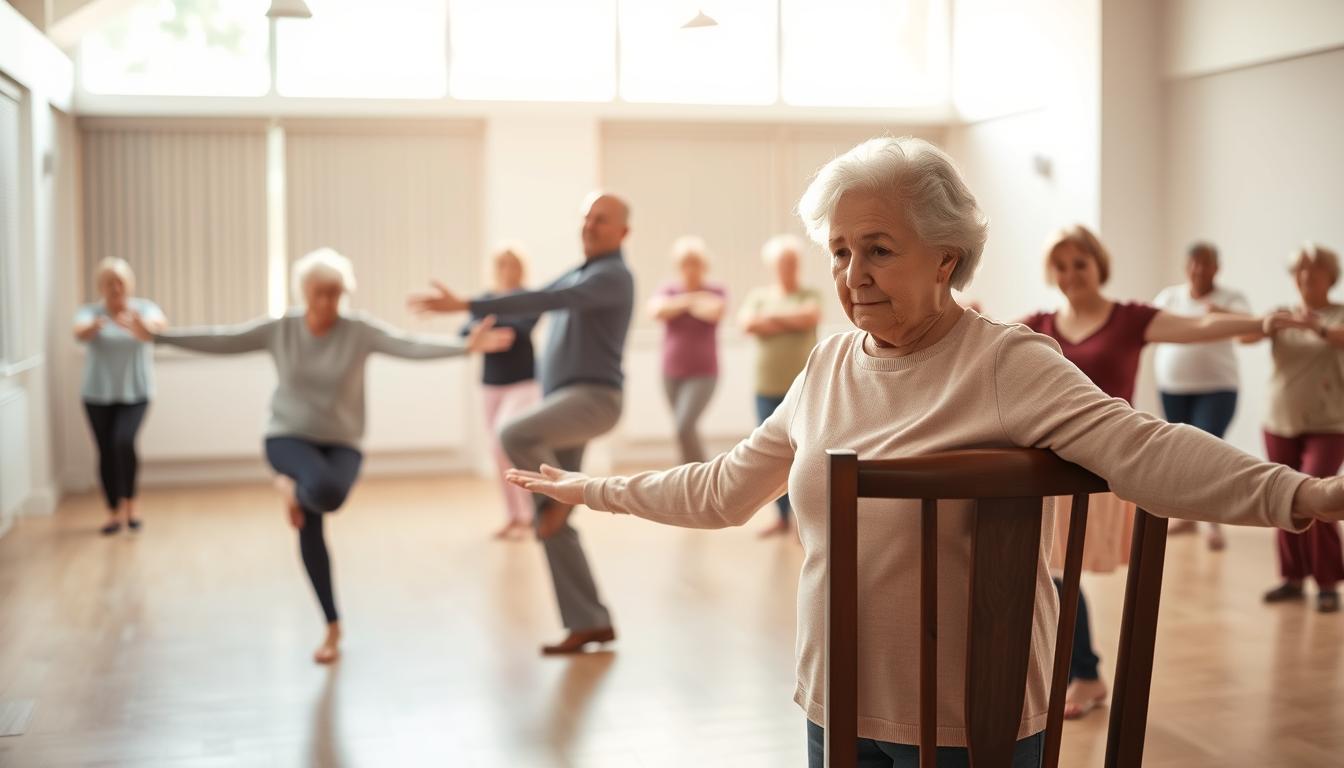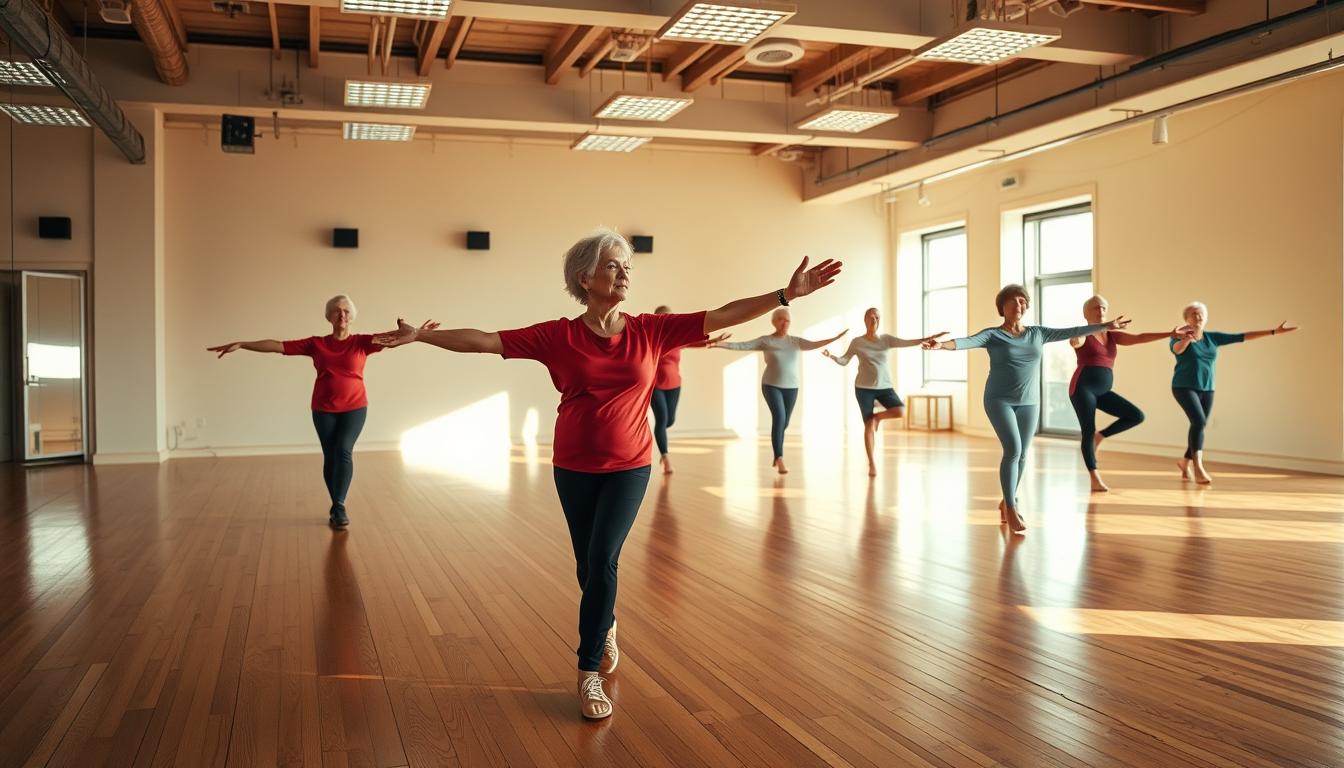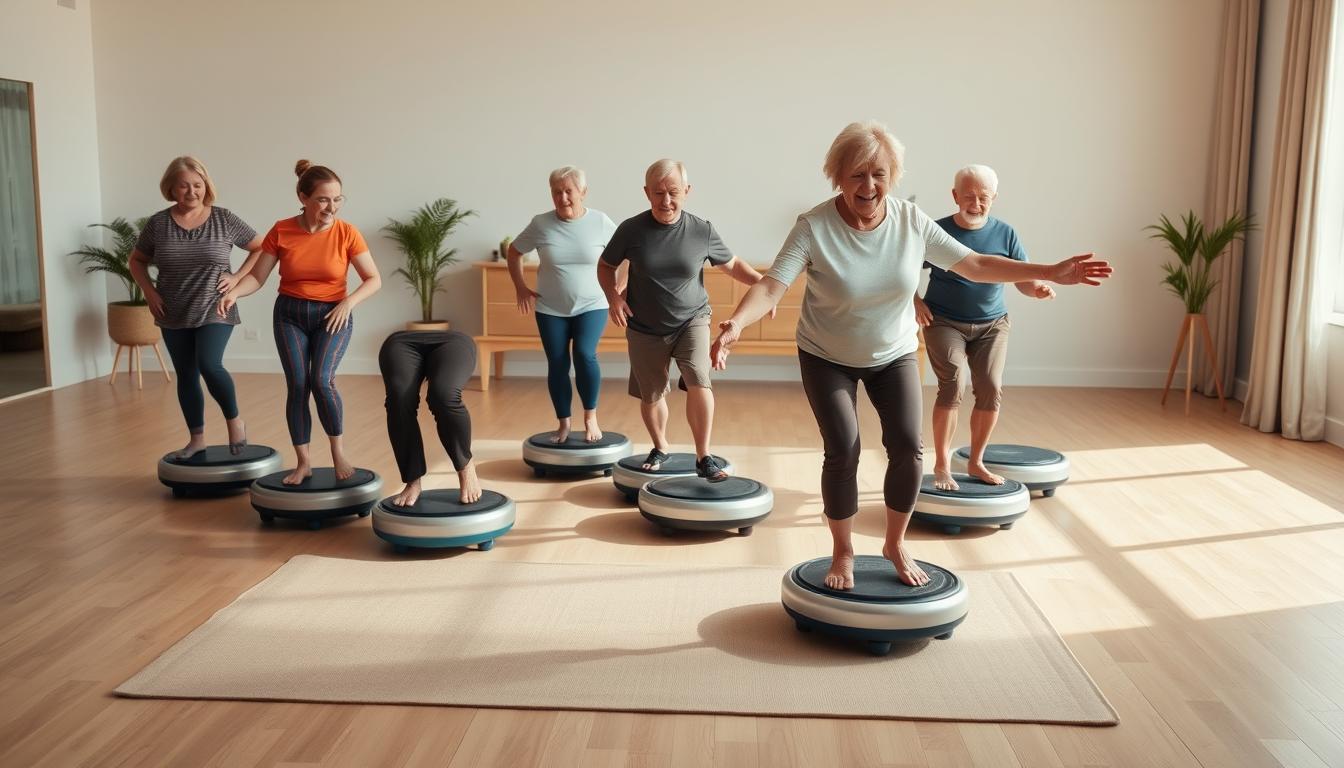Want to build strength without feeling like you’re training for the Olympics? Grab that oversized inflatable orb collecting dust in your garage. Trust me, it’s not just for yoga influencers. SilverSneakers regulars swear by these moves to fire up their core, improve posture, and laugh through the wobbles.
I’ve seen 70-year-olds in my local class out-squat millennials using these things. The secret? You’re not just sitting—you’re engaging muscles from your shoulders to your toes. Think “gentle turbulence” for your spine. One participant told me her grandkids now call her “the human Weeble” after she nailed her seated marches.
Here’s the no-BS breakdown: We’ll tackle seated leg lifts (knees bent, feet flat—no acrobatics), side-to-side reaches (hello, obliques!), and modified planks that won’t leave you stranded on the floor. Bonus? You’ll work your arms and thighs without realizing it. Science says 10 minutes daily can boost coordination better than crossword puzzles. Who knew?
You don’t need Spandex or a gym membership. Just a clear patch of carpet and the willingness to giggle when you tip over. Ready to out-crunch your grandkids? Let’s roll.
Understanding the Science Behind Stability and Core Engagement
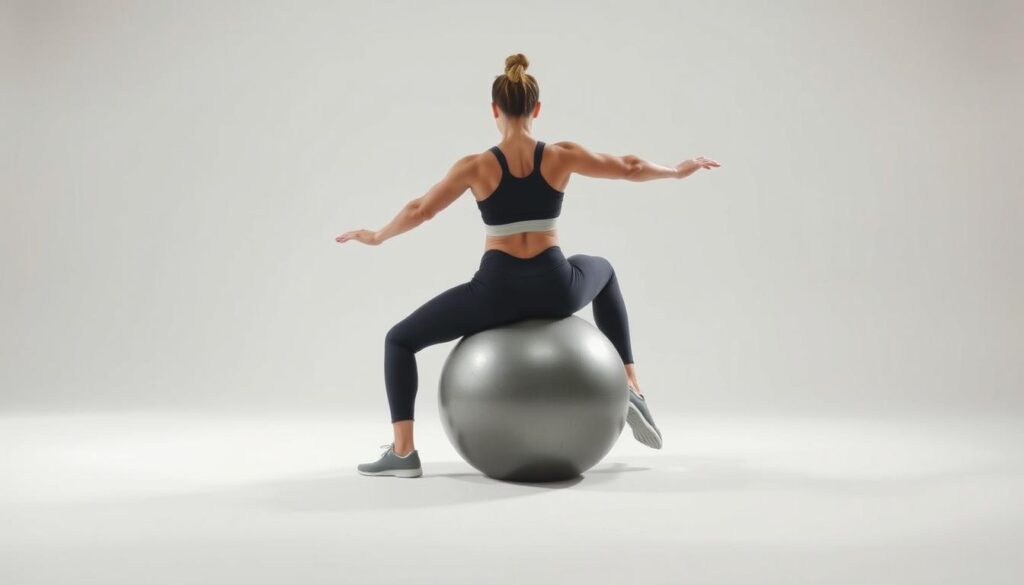
Ever wonder why your body feels lighter after rocking side-to-side on that squishy sphere? It’s not magic—it’s physics. When you sit on an exercise ball, your core muscles kick into overdrive just to keep you upright. A 2023 AARP study found participants using these tools activated 40% more abdominal fibers compared to chair-based workouts. Think of it as your body’s natural alarm system—wobble equals work.
Exploring Core Muscle Activation with Real Examples
Take seated marches: lifting one knee forces your hips and lower back to stabilize. My client Martha (72) calls this her “stealth workout” because she’s secretly toning while watching Jeopardy! The key? Controlled instability. Your muscles adapt faster when challenged gently—like how standing on a moving bus trains your reflexes.
| Position | Muscles Engaged | Daily Life Benefit |
|---|---|---|
| Feet Flat on Floor | Calves, Quads | Easier stair climbing |
| Leaning Slightly Left | Obliques, Glutes | Better grocery bag carrying |
| Arms Extended Forward | Shoulders, Upper Back | Improved reach for top shelves |
How Proper Posture Influences Balance in Everyday Tasks
Slouching isn’t just a bad look—it’s a stability killer. Aligning your spine on the ball mimics how your body should position itself when lifting grandkids or reaching for coffee mugs. Research shows maintaining this posture for 10 minutes daily can reduce “off days” by 22%. Pro tip: Imagine a string pulling your head toward the ceiling. Your hips will thank you later.
Choosing the Right Stability Ball and Setup for Safety
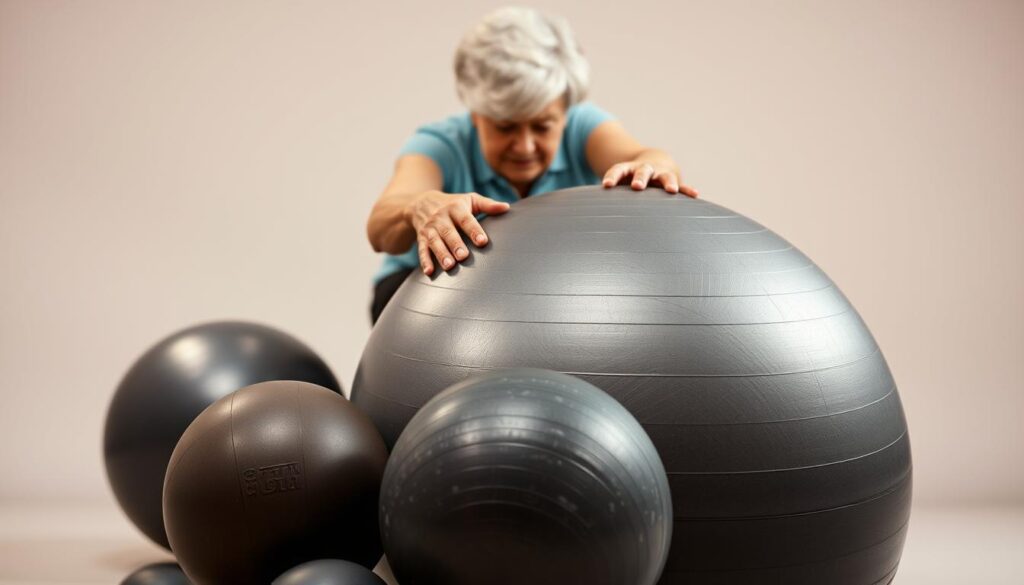
Let’s get real—your inflatable workout buddy isn’t one-size-fits-all. Pick the wrong sphere, and you’ll either feel like Alice in Wonderland or a sardine in a kiddie pool. Here’s the sweet spot: When seated, your knees should bend at 90 degrees with feet flat. If your hips dip below knee level, size up. Too tall? Downsize before you faceplant.
Ball Size, Material, and Safe Placement Tips
Anti-burst models are non-negotiable—trust me, you don’t want a surprise deflation mid-march. Look for thickness ratings (600kg+ capacity) and textured surfaces that grip like your favorite yoga pants. Place it against a wall during your first few sessions—it’s like training wheels for your pelvis.
| Height Range | Ball Diameter | Pro Placement Tip |
|---|---|---|
| 5’0″ – 5’4″ | 55cm | Use on carpet for gentle resistance |
| 5’5″ – 5’9″ | 65cm | Pair with yoga mat for slippage control |
| 5’10″+ | 75cm | Anchor near sturdy furniture initially |
Hardwood floors? Add a nonslip mat underneath—your future self will high-five you. And hey, if your grandkid’s playroom ball is calling your name, check its weight limit first. Pro tip: Inflate until firm but slightly yielding, like a ripe avocado. Squishy balls encourage slouching; overinflated ones feel like concrete.
Step-by-Step Guide to Stability Ball Balance Exercises
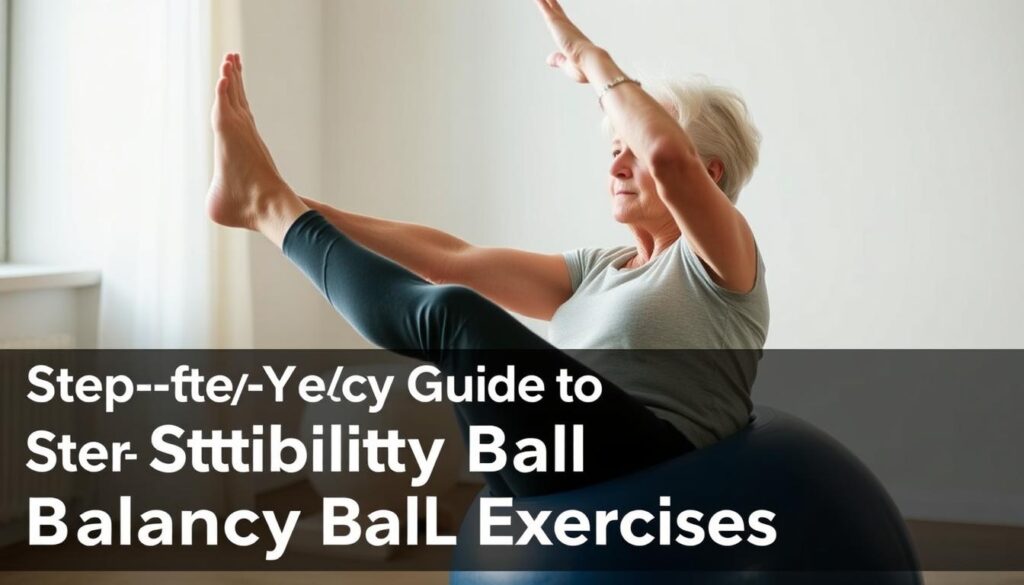
Let’s get moving—but first, let’s not pull a muscle. I’ll walk you through a foolproof routine that’s safer than your morning toast. Pro tip: Clear space around you—we’re aiming for graceful swaying, not interpretive dance collisions.
Essential Warm-Up and Safety Practices
Start seated with feet planted like tree roots. Roll your shoulders backward 5 times—think of opening a stubborn jar. Next, gently shift weight side-to-side. This wakes up your hips without shocking your system. Trust me, cold muscles hate surprises.
| Warm-Up Move | Target Area | Duration |
|---|---|---|
| Seated Marches | Hips & Lower Back | 2 Minutes |
| Arm Circles | Shoulders | 1 Minute |
| Pelvic Tilts | Core | 90 Seconds |
Movements Tailored for Older Adults
1. Seated Leg Lifts: Keep both feet on the floor. Lift one heel an inch—hold 3 seconds. Alternate sides. Works wonders for ankle stability.
2. Side Reach: Place hands on hips. Lean left until you feel tension (not pain). Return slowly. Repeat right.
3. Spine Stretch: Roll forward until shoulders hover over knees. Imagine reaching for the TV remote just out of grasp.
Always finish with feet flat on the floor for 30 seconds. Your body needs a “reset button” after these moves. Heard complaints about chair stands? This routine’s your secret weapon.
Stability Ball Balance Exercises for Seniors
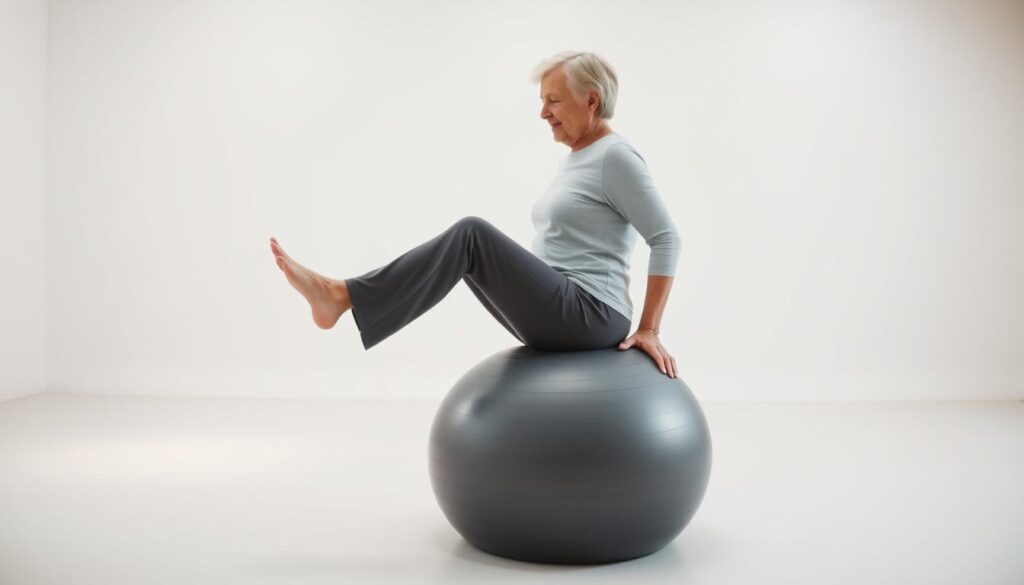
Time to level up your couch-to-fridge struts. These sneaky-good moves build power where it counts—your foundation. My neighbor Ed (68) swears his golf swing improved after two weeks of these variations. “Feels like I’ve got shock absorbers in my legs now,” he told me last week.
Game-Changing Moves You’ll Actually Enjoy
1. Wall-Assisted Squats: Place the sphere between your lower back and a wall. Slowly lower like you’re sitting in an invisible chair. Works quads and teaches proper spine alignment. Start with 5 reps—your thighs will chat with you tomorrow.
2. Side-Lying Leg Lifts: Lie on your left hip, ball squeezed between ankles. Lift right leg like you’re kicking a beach ball gently. Targets those hard-to-reach outer thigh muscles. Pro tip: Imagine you’re drawing circles with your big toe.
3. Seated Tilt ‘n’ Twist: Feet planted, hands behind head. Lean back until you feel your abs engage, then rotate right elbow toward left knee. Perfect for that “I need to grab something from the backseat” motion. Do 8 per side—bonus points if you hum a tango rhythm.
Keep sessions short but sweet. Three 10-minute bouts spread through the day work better than marathon sessions. And hey, if you tip over? That’s just your body’s way of saying “Let’s try that again tomorrow.”
Tracking Progress and Tweaking Your Routine
![]()
Let’s face it—measuring fitness gains shouldn’t require a PhD in data science. Your inflatable workout partner offers built-in feedback if you know where to look. I’ve seen retirees track improvements using methods simpler than their morning crossword.
Measuring Improvement Through Simple Metrics
Start with “can I…” checks. Can you lift your knees higher during seated marches than last week? Hold a side reach for three extra breaths? These micro-wins matter. My SilverSneakers crew swears by tracking three things:
- Reps before wobble: How many leg lifts can you do before needing to steady yourself?
- Floor-to-ball time: Time how fast you transition from chair to stable seated position
- Daily wins: Note when real-life movements (like bending for mail) feel easier
Grab a dollar-store notebook. Jot down numbers every Friday—it’s like Yelp reviews for your muscles. Pro tip: If you’re nailing 12 reps easily, add 2 more or slow your tempo. Your body thrives on gentle challenges.
Adjustments should feel like swapping TV channels—not rebuilding the set. Sore wrists during planks? Try forearm variations. Feet sliding? Add grippy socks. One client replaced her 65cm sphere with a 55cm model and finally nailed her pelvic tilts.
Remember: Progress isn’t linear. Some weeks you’ll feel like a gymnast, others like a newborn giraffe. That’s normal. Celebrate the days you show up—consistency beats perfection every time.
Parting Words on Achieving a Balanced Core
Here’s the truth no one tells you about fitness after 60: consistency beats intensity every time. That slightly deflated sphere in your living room? It’s not just equipment—it’s your partner in rewriting what’s possible for your body.
I’ve watched clients transform how they move through life—grabbing grandkids without wincing, reaching for top shelves like they’ve grown two inches. The magic happens when you show up daily, even for five minutes. Your chair marches today become effortless garden squats next season.
Three things to remember:
1. Small tweaks create big shifts. Can’t hold a side reach? Try bending less. Feet sliding? Wear socks with grips. Progress lives in these adjustments.
2. That upright sitting posture? It’s training for real life. Every minute on the ball strengthens your body’s natural scaffolding.
Your journey isn’t about perfection—it’s about showing up. One client keeps her stability ball by the TV “to guilt me into moving during commercials.” Another uses wall-assisted squats while waiting for coffee to brew. That’s how habits stick.
Keep your routine fresh but familiar. Swap seated marches for gentle twists. Add a pillow under your feet if needed. And when frustration hits? Remember: wobbling means you’re working smarter, not harder.
Now go outshine those grandkids.

